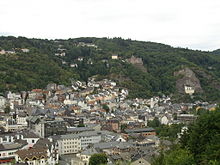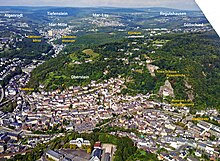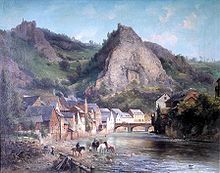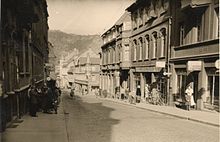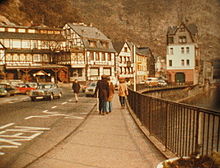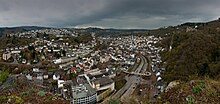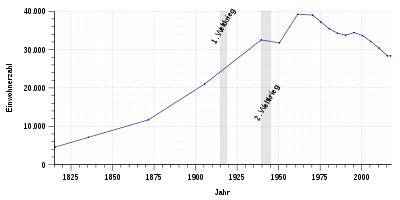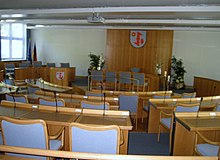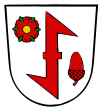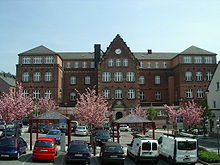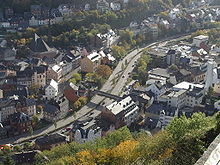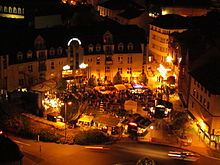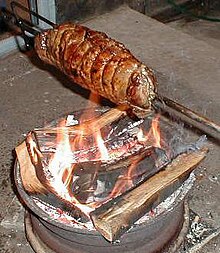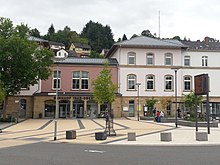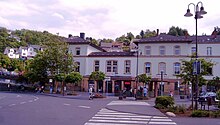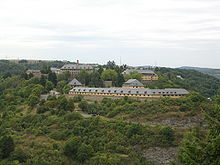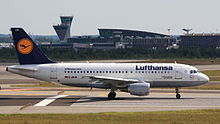Idar-Oberstein
| coat of arms | Germany map | |
|---|---|---|
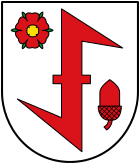
|
Coordinates: 49 ° 43 ' N , 7 ° 19' E |
|
| Basic data | ||
| State : | Rhineland-Palatinate | |
| County : | Birch field | |
| Height : | 272 m above sea level NHN | |
| Area : | 91.54 km 2 | |
| Residents: | 28,520 (Dec. 31, 2019) | |
| Population density : | 312 inhabitants per km 2 | |
| Postal code : | 55743 | |
| Primaries : | 06781; 06784 (districts: Georg-Weierbach, Kirchen-, Mittel- and Nahbollenbach, Weierbach) | |
| License plate : | BIR | |
| Community key : | 07 1 34 045 | |
| City structure: | 13 districts | |
City administration address : |
Georg-Maus-Strasse 1 55743 Idar-Oberstein |
|
| Website : | ||
| Lord Mayor : | Frank Frühauf ( CDU ) | |
| Location of the city of Idar-Oberstein in the Birkenfeld district | ||
Idar-Oberstein is a district town in the Birkenfeld district , Rhineland-Palatinate . The association-free city is the result of extensive administrative and structural reforms in 1933, 1969 and 1970. The gemstone and garrison city with almost 30,000 inhabitants is the most populous municipality in the district and a medium-sized center . The municipality has had the title of National Park City since 2016.
geography
Geographical location
Idar-Oberstein is located on the southern edge of the Hunsrück on both sides of the Nahe . Larger cities in the vicinity are Trier (approx. 50 kilometers to the west), Bad Kreuznach (approx. 30 kilometers to the northeast) and Kaiserslautern (approx. 35 kilometers to the southeast). The city lies on the edge of the Hunsrück-Hochwald National Park . The city draws its water supply from the Steinbachtalsperre .
City structure and population
As of December 31, 2015 , the State Statistical Office of Rhineland-Palatinate registered a total of 16,757 apartments in 9,451 residential buildings in the city of Idar-Oberstein .
The city had a total of 32,001 residents as of the same date, including 1,994 registered secondary (secondary) residences.
Old town, merger with the administrative reform of 1933
- Algenrodt (1,846 inhabitants)
- Idar (7,897 inhabitants)
- Tiefenstein (2,489 inhabitants)
- Oberstein (7,834 inhabitants)
Population of the old town as of December 31, 2015: 20,066
Newer districts, incorporated with the administrative reform 1969/70
- Enzweiler (686 inhabitants)
- Georg-Weierbach (661 inhabitants)
- Göttschied (2,928 inhabitants)
- Hammerstein (504 inhabitants / area 217.5 ha)
- Kirchenbollenbach (787 inhabitants / area 227.5 ha)
- Mittelbollenbach (1,060 inhabitants / area 360.9 ha)
- Nahbollenbach (1,899 inhabitants / area 821.7 ha)
- Regulshausen (874 inhabitants)
- Weierbach (2,536 inhabitants / area 751.6 ha)
Population of new districts as of December 31, 2015: 11,935
climate
The following values relate to the period 1961–1990, i.e. values of the long-term climatological mean. For the temperatures, the arithmetic mean of the average temperatures on the days of the respective months is calculated. For the precipitation values, the sum of all precipitation is calculated, the unit is mm (millimeters).
|
Average monthly temperatures and rainfall for Idar-Oberstein
Source: DWD
|
||||||||||||||||||||||||||||||||||||||||||||||||||||||||||||||||||||||||||||||||||||||
The annual amount of precipitation is 774 mm. The precipitation is in the middle third of the values recorded in Germany. Lower values are registered at 57% of the measuring stations of the German Weather Service . The driest month is April, with the most rainfall in December. In December there is 1.6 times more rainfall than in April. Precipitation hardly varies and is evenly distributed over the year. Lower seasonal fluctuations are recorded at only 13% of the measuring stations .
history
The city of Idar-Oberstein is a municipality that has only existed since October 1, 1933. Before that, the individual districts developed very differently.
Antiquity and the Middle Ages
- Oberstein
The Oberstein district developed out of the imperial direct rule of Oberstein. The Lords of Stein (Oberstein) , first mentioned in 1075, had their seat above the later built rock church , at Bosselstein Castle , which was mentioned as early as the 12th century and is known as the "Old Castle". The core area of the rule was limited by the Nahe, Idarbach, Göttenbach and Ringelbach. In the middle of the 13th century, the Obersteiners split into the warring lines of the "Lords of Oberstein" (Bosselstein Castle) and "von Daun-Oberstein" ( Oberstein Castle ). The former eventually left the area and the latter were able to expand their sphere of influence considerably, including to areas south of the Nahe and the Idarbann. As the seat of the manor with the castle and the fortifications - remnants of the city wall built around 1410 are still visible today "Im Gebück" - Oberstein was able to develop an urban character without, however, going beyond the legal status of a town . In 1682 the Counts of Leiningen- Heidesheim and in 1766 the Counts of Limburg-Styrum became owners of the Oberstein dominion, which essentially merged into the aforementioned core area after the Idarbann was annexed to the rear county of Sponheim in 1771 . In 1776 the margraves of Baden became the owners of the estate after the rear county of Sponheim was divided.
- Idar
The settlement of Idar can be proven up to the earliest times by archaeological finds. The place Idar to the right of the Idarbach belonged to the Idarbann with the places Enzweiler, Algenrodt, Mackenrodt, Hettenrodt, Hettstein, Obertiefenbach and Kirschweiler . The area belonged predominantly to the Lords of Oberstein and thus shares the history with Oberstein, but in Tiefenbach and Kirschweiler in particular the Wild and Rhine Counts and the Tholey Abbey had goods and other rights.
- Other districts
The place Tiefenstein arose from the amalgamation of the places Tiefenbach and Hettstein in 1909. The territorial history of the Idarbann community corresponds to that of Idar and Oberstein. Tiefenbach is mentioned as a farm in a document from 1283; a mention of 1051 cannot be assigned with certainty to the place. Hettstein was mentioned in 1321 as Henzestein or Hezerten and had, among other things, wildgrave subjects as residents.
The village of Algenrodt is first mentioned as Alekenrod in an Oberstein fief deed from 1321. In 1324 it was pledged by the Lords of Oberstein to the Kyrburg Wild and Rhine Counts. Incidentally, Algenrodt shares the story with the other Idarbann communities.
Enzweiler can prove traces of settlement up to Roman times. In 1276 Tholey Abbey owned a mill near Enzweiler. The place itself was probably created in the 14th century and was always part of the Idarbann.
The town of Georg-Weierbach, located north of the Nahe in terraces on a steep terrain sloping towards the Nahe, probably goes back to a church founded by Archbishop Hatto of Mainz in the 10th century. In 1155 the place is mentioned in connection with the Lords of Wirebach (= Weierbach). In 1327 the place, which was briefly owned by the von Randeck family, was largely sold to the Counts of Wild and Rhine and assigned to the Kyrburg office. The name Georg-Weierbach comes from the patronage of the church.
Göttschied, first mentioned in a document in 1271, belonged together with Regulshausen, Gerach and Hintertiefenbach to the Mettlach Abbey (" Abbey Villages"). In 1561 these villages were sold to the rear county of Sponheim.
Hamerzwiller (= Hammerstein) is mentioned in 1438 in the valid book of the County of Sponheim and was already in Hintersponheim possession in 1269, when it was given as a fief to the Count of Schwarzenberg.
A church founded by the Archbishop of Mainz Williges after 975 is regarded as the origin of the village of Kirchenbollenbach. The place is documented for the first time in 1128 under the name "Bolinbach". Initially occupied as a fiefdom of the Lords of Schwarzenberg by the Counts of Zweibrücken, the place came to the Kirner Wild and Rhine Counts in 1595. A regional peculiarity is that in the further course a Catholic branch of the predominantly Protestant Rhine Counts under Prince Johann Dominik von Salm- Kyrburg introduced the Simultaneum in Kirchenbollenbach and founded a new (Catholic) parish.
The Bollenbach farm , which was mentioned in 1283 as a property of the Lords of Oberstein in the area of the Winterhauch forest, is considered to be the cornerstone of Mittelbollenbach . In 1432, the dukes of Lorraine were enfeoffed with Nah- and Mittelbollenbach, which led to bitter disputes after the Oberstein line was extinguished because of the complicated succession. It was not until 1778 that the Lothringers renounced in favor of Kurtrier .
Until 1667, Nahbollenbach's history corresponds to that of Mittelbollenbach. Then Nahbollenbach was recognized by Lorraine as an allodial possession of Oberstein, but remained under the rule as an Electorate of Trier fiefdom from 1682.
The abbey village Regulshausen belonged to the Mettlach Abbey and was sold by this to the rear county of Sponheim in 1561. The oldest documentary mention is from 1491.
Weierbach is mentioned for the first time in 1232 as "Weygherbach" and belonged to the Naumburg Office in Vordersponheim . The later owners of the Vordere Grafschaft Sponheim were the Margraves of Baden , which made the place known under the name Baden-Weierbach. The frequently used name Martin-Weierbach comes from the patronage of the church.
Modern times
French rule
After the dissolution of the old rulers, the new French masters brought about a comprehensive reorganization of the territorial (and social) structure from 1794. The entire area belonged to the Birkenfeld arrondissement in the Département de la Sarre and was nominally French territory from November 4, 1797 and, according to the agreements at the Treaty of Lunéville , officially from March 9, 1801 until 1814. The introduction of the civil code , a judicial reform and, in particular, the abolition of the nobility and clergy, with the associated elimination of labor and other burdens, quickly made French rule popular. However, the enormous tax burden and the constant levies in favor of the French army put pressure on the people of the region.
Prussia and Oldenburg
After the end of Napoleonic rule, the space was restructured again. On the basis of Article 25 of the Final Act of the Congress of Vienna , the northern part of the Département de la Sarre came to Prussia in June 1815 . A Prussian district office was established in Oberstein. Since Prussia had committed itself in the Paris Peace of 1815 to hand over an area of this area with a total of 69,000 inhabitants to the Duke of Saxe-Coburg-Saalfeld (20,000 souls), the Duke of Oldenburg (20,000 souls) and other small princes and this was stipulated in Article 49 of the Final Act of the Congress of Vienna, there was a further division of the region.
The towns of Hammerstein, Kirchenbollenbach, Mittelbollenbach, Nahbollenbach and Martin-Weierbach, as well as the Homerischer Hof, located south of the nearby towns, came to the Lichtenberg Principality of the Dukes of Saxony-Coburg-Saalfeld in 1816 . The Coburg dukes were not satisfied with this gain, just as the inhabitants of the Principality of Lichtenberg were dissatisfied with the Coburgs. In 1834 the area was sold by Saxe-Coburg and Gotha to Prussia for two million thalers and converted into the St. Wendel district , from which parts of the district that were not integrated into the Saar area became the remainder of Sankt Wendel-Baumholder after the First World War . The Prussians were also not loved because they enforced their own order partly with military power. It was said that they u. a. In response to a call for help from Coburg for the Hambach Festival in May 1832, a protest rally in St. Wendel , where a tree of freedom was planted in Napoleonic tradition , ended with military force.

On April 16, 1817, Idar, Oberstein, Tiefenstein, Algenrodt, Enzweiler, Georg-Weierbach, Göttschied and Regulshausen became part of the newly created Oldenburg Principality of Birkenfeld in the Oberstein district with the mayorships of Herrstein, Oberstein and Fischbach. The French legislation remained in place, but the Duke passed a constitutional law , which the population disagreed with, because they would have preferred to stay with Prussia. This continuation of the small German states was viewed very critically, especially in Idar and Oberstein, in contrast to Birkenfeld, which had now risen to become a royal seat . The jewelery industry, which at the time was already supraregional to international, and the gemstone dealers who were world-class despite their provinciality, felt this, especially after years of belonging to France with the fashionable metropolis of Paris and the good business done there, as a step backwards. Partly energetic, but unsuccessful, the renewed connection to Prussia. Nevertheless, the Oldenburgers were able to quickly make themselves popular with the population because they installed a disinterested administration, ensured independent jurisdiction and initiated a variety of activities in favor of the farmers and the economy. An orderly school system (a community school was established in Oberstein in 1830) and the temporary waiver of recruitment for military service supported this positive image. Roads were expanded and a driving post was set up. The construction of the Nahe Railway and the commissioning of the line from Bad Kreuznach to Oberstein on December 15, 1859 led to a further economic boom. In 1865, the municipalities of Oberstein and Idar were formally granted city rights by Oldenburg
Empire, Weimar Republic and Third Reich
When the empire was founded in 1871, the municipalities and cities belonged to the German Empire . After the end of the First World War, the Oldenburg Grand Duke Friedrich August renounced his throne. The Principality of Birkenfeld became the Birkenfeld part of the Free State of Oldenburg . The Birkenfeld region was occupied on December 4, 1918, like the entire Rhineland, by French troops, who only withdrew on June 30, 1930 (see Allied occupation of the Rhineland ). After the fall of the empire, the communities remained part of the German empire , which had now been converted into a republic .
In the Oldenburg state election on May 17, 1931 , the NSDAP received over 37 percent of the votes, but was not yet able to form the government. After the NSDAP had initially issued a declaration of tolerance for the existing government, it soon demanded the dissolution of the state parliament. Since the latter refused to dissolve, the National Socialists initiated a referendum that led to a referendum , with which the Oldenburg State Parliament was dissolved on April 17, 1932. This resulted in a largely free new election to the Oldenburg state parliament on May 29, 1932 , which led to a victory for the NSDAP with a total of 48.38 percent of the votes, which gained 24 of 46 seats - an absolute majority. In the city of Idar, the National Socialists received over 70 percent of the votes cast. This enabled them to rule in the Oldenburg region of the German Reich with the approval of the German National People's Party , which had two seats, even before the official takeover of power. One of the first initiatives of the new rulers was the enactment of an administrative reform for the state of Oldenburg, which was followed on April 27, 1933 by the similar law to simplify and reduce the cost of administration for the state of Birkenfeld. A total of 18 formerly independent towns were merged , including the previously independent towns of Idar and Oberstein with the communities of Algenrodt and Tiefenstein to form the new town of Idar-Oberstein. The law was enforced within a few weeks without further discussion or participation, in camera, and also against the will of uninspired communities such as Herrstein and Oberwörresbach, Rötsweiler and Nockenthal, Hoppstädten and Weiersbach. The National Socialists under the district leader Herbert Wild from Idar occupied all important public positions until the end of the Nazi Empire. On October 1, 1933, the cities of Oberstein and Idar were merged to form today's city of Idar-Oberstein.
In 1937, on the basis of the Greater Hamburg Law, the Oldenburg region of Birkenfeld was dissolved and transferred with the remaining district of Sankt Wendel-Baumholder to the Prussian district of Birkenfeld, to which all the communities in what is now Idar-Oberstein belonged. In the course of the remilitarization of the Rhineland , Idar-Oberstein became a German garrison town from 1938.
Federal Republic of Germany
After the Second World War , today's urban area belonged to the area of the French occupation zone and the district of Birkenfeld became part of the federal state of Rhineland-Palatinate . In the course of the Rhineland-Palatinate municipal reform , nine surrounding municipalities were incorporated. On June 7, 1969 the communities Enzweiler, Göttschied, Hammerstein and Regulshausen were incorporated, on November 7, 1970 Georg-Weierbach , Kirchenbollenbach , Mittelbollenbach , Nahbollenbach and Weierbach were incorporated . This territorial reform was preceded by extensive, partly covert talks with the then Mayor of Idar-Oberstein, Wittmann, with negotiation offers to a total of 22 municipalities in the surrounding area ("surrounding area talks"). One of the reasons was the then noticeable emigration of Idar-Oberstein citizens to the surrounding communities, which provided extensive new building areas - including Göttschied, Rötsweiler-Nockenthal and Kirschweiler - while there were hardly any such new building areas in the city itself due to the problematic structure of the terrain. There was also a lack of suitable areas for industrial settlements in the urban area. Weierbach's application for membership, which was expressed without a previous Idar-Obersteiner initiative, was surprising. At the time, this did not yet border on the city of Idar-Oberstein and was intended as a nucleus for a new large municipality or city, which was to consist, among other things, of the communities Weierbach, Fischbach, Georg-Weierbach and Bollenbach, which were then to be merged.
On April 1, 1960, the city of Idar-Oberstein was declared a city belonging to a large district by the state government at their request . With the exception of Georg-Weierbach, the majorities in the towns and municipal councils in favor of the dissolution of the respective municipality and the subsequent accession to the city of Idar-Oberstein were very clear. Nevertheless, there were bitter discussions and administrative disputes, especially in the former Weierbach office, which was now deprived of its core communities. In April 1970, the Weierbach Office lodged a constitutional complaint with the Rhineland-Palatinate Constitutional Court , which ruled on July 8, 1970 that the state law on administrative simplification in Rhineland-Palatinate was in parts unconstitutional. The self-administration right of the Weierbach office is impaired by the law and the viability of the community association is endangered. With this, Weierbach, Georg-Weierbach, Nah-, Mittel- and Kirchenbollenbach were again excluded and independent with immediate effect. After bitter disputes between the city of Idar-Oberstein together with the merger advocates on the one hand and the Weierbach office and the opponents of the merger on the other, who expressed their convictions in demonstrations, meetings or letters to the editor, a public survey with a vote in the Weierbach office took place in early September 1970. The result corresponded to the previous status: the municipalities previously separated by a court order voted for the connection to Idar-Oberstein with almost 80 percent of the votes cast, while the other municipalities of the Weierbach district - Sien , Sienhachenbach , Schmidthachenbach , Fischbach , Zaubach and Dickesbach - also voted a quota of around 95 percent voted to keep the Weierbach office.
With this city expansion, the focus in the Birkenfeld district had shifted significantly. Idar-Oberstein was able to develop further as a medium-sized center: the school landscape was expanded (Realschule, Heinzenwies-Gymnasium ), new building areas could be identified (especially in Göttschied, Regulshausen and Weierbach), there was space for a new hospital building and new areas for industrial and commercial settlements were available (for example Globus-Handelshof in Weierbach and the shopping center EKZ in Vollmersbach).
Since Idar-Oberstein not only had a good general infrastructure, but also had more than sufficient water supplies after the Steinbachtalsperre went into operation, the option to join was attractive for many other municipalities. On the initiative of the Lord Mayor Wittmann, who had an expert report by an Osnabrück planning office to investigate the relationship between the city and 25 other neighboring communities, the "unconditional incorporation" of the communities Fischbach, Dickesbach, Zaubach, Mittelreidenbach, Oberreidenbach, Schmidthachenbach, Sienhachenbach, Sien, Hintertiefenbach and Vollmersbach required. The municipalities of Rötsweiler-Nockenthal, Siesbach, Gerach, Veitsrodt, Kirschweiler, Hettenrodt and Mackenrodt should receive an offer of integration. As a result, the district administration in Birkenfeld became active and a district council resolution was passed in which the inconsiderate policy of the city of Idar-Oberstein was condemned. Since the accession municipalities and the city of Idar-Oberstein itself had become somewhat disillusioned with the incorporation, all further initiatives failed or were discontinued.
On January 1, 1994, the Baumholder manor district , which included the military training area, was dissolved, with several parcels of land on which the districts of settled communities were also falling to the city of Idar-Oberstein, which increased its urban area in this way.
Economic history
The towns of Idar and Oberstein developed from the middle of the 19th century into one of the four most important jewelery centers in Germany, alongside Pforzheim , Hanau and Schwäbisch Gmünd . Due to the natural occurrence of agates , jasper and other precious stones, the professions of agate cutter and later also of agate drill emerged in Idar and Oberstein. As a result, goldsmiths settled in the region around 1660 , because by setting the agate goods, their sales opportunities could be increased. The goldsmiths mainly settled on the Obersteiner Naheufer, while the agate cutters on the Idarbach because of the better water conditions for operating the whetstones. Since the Nahe flooded regularly, it would have flooded the grinding mills. For the goldsmiths, however, the Nahe was ideal because they needed water for many work processes. That is why all early factories were founded on the Obersteiner Naheufer.
Around the middle of the 18th century, the regional agate deposits were exhausted. From then on, Brazilian agate was processed in Idar, in Oberstein there was a development towards pure metal goods production, and the goldsmith's trade emancipated itself from agate grinding. This led to the founding of numerous watch chain factories in Oberstein at the end of the 19th century , which became a globally important branch of industry. With the advent of the wristwatch during the First World War, production was increasingly switched to fashion jewelry. The big names were z. B. Jakob Bengel, Klein & Quenzer, Ziemer & Sons, Carl August Haupt, Gebrüder Stern, Gottlieb & Wagner, Carl Maurer Sohn, Walter Fischer, Ernst Schindler - Prägeanstalt - and many more. With the emergence of stricter environmental regulations and competition from low-wage countries in the 1970s Years ago the situation for the fashion jewelry factories became more and more difficult. But there are still some jewelry factories from the early days in Idar-Oberstein. In the industrial monument Jakob Bengel, a jewelry factory has been preserved in its original state, which can be visited. The district of Idar was and still is partly the world trading center for gemstones next to Antwerp and Amsterdam , but the main focus is on the diamond trade. In the heyday, around 7,000 diamond cutters were employed for the Idar diamond cutters, as well as several thousand agate and gemstone cutters.
Population development
|
|
Source: State Statistical Office Rhineland-Palatinate
politics
City council
The city council in Idar-Oberstein consists of 40 honorary council members, who were elected in a personalized proportional representation in the local elections on May 26, 2019 , and the full-time mayor as chairman.
The distribution of seats in the city council:
| choice | SPD | CDU | FDP | GREEN | LEFT | REP | FL | LUB | total |
|---|---|---|---|---|---|---|---|---|---|
| 2019 | 12 | 12 | 4th | 4th | 2 | - | 3 | 3 | 40 seats |
| 2014 | 14th | 13 | 4th | 2 | 2 | - | 2 | 3 | 40 seats |
| 2009 | 12 | 11 | 7th | 2 | 2 | - | 3 | 3 | 40 seats |
| 2004 | 13 | 16 | 3 | 2 | - | 1 | 3 | 2 | 40 seats |
- FL = Free List Idar-Oberstein e. V.
- LUB = List of Independent Citizens Idar-Oberstein e. V.
Lord Mayor
On April 1, 1960, the state of Rhineland-Palatinate granted the town of Idar-Oberstein the special status under local law as a “ large town belonging to the district ”. Since then, the heads of administration have held the title of mayor .
| from | to | Surname | Political party | Remarks |
|---|---|---|---|---|
| 1920 | July 30, 1933 | Ludwig Bergér | Mayor of Oberstein | |
| July 30, 1933 | Otto Schmidt | Mayor of Idar | ||
| Aug 1, 1933 | May 9, 1945 | Ludwig Bergér | Mayor of Idar-Oberstein | |
| May 10, 1945 | Apr 29, 1947 | Walter Rommel | City Manager (arrested and deposed by the French occupation forces) | |
| 22 Sep 1946 | Feb. 4, 1949 | Emil Lorenz | honorary mayor | |
| Feb 5, 1949 | 1953 | Ernst Herrmann | full-time mayor | |
| Dec 15, 1953 | 31 Mar 1960 | Leberecht Hoberg | CDU | mayor |
| Apr 1, 1960 | Apr 8, 1968 | Leberecht Hoberg | CDU | Lord Mayor |
| 1968 | 26 Sep 1974 | Wilfried Wittmann | SPD | divorced from office by voting out |
| 1977 | Feb 28, 1991 | Erwin Korb | SPD | |
| 1st Mar 1991 | Feb 28, 2001 | Otto Dickenschied | SPD | |
| 1st Mar 2001 | Feb 28, 2007 | Hans Jürgen Machwirth | CDU | first directly elected mayor after the 1994 electoral reform; retired after reaching the age limit for municipal electoral officials of 68 years before the end of the 8-year term of office |
| 1st Mar 2007 | Feb 28, 2015 | Bruno room | SPD | elected by direct election on November 5, 2006 |
| 1st Mar 2015 | Frank Frühauf | CDU | elected Lord Mayor for eight years by runoff on October 12, 2014 |
Economic Advisory Board

On March 16, 2016, the Idar-Oberstein city council decided to set up an economic advisory council. This consists of appointed representatives from regional companies. They are non-partisan experts from industry, trade, the service sector and retail. Members of banks and professional associations are also present. The task of the advisory board is to advise the administration on economic issues and to draft resolution proposals for the city council. The advisory board works within the framework of rules of procedure adopted by the city council.
coat of arms
| Blazon : "In silver, a standing left-facing red forest hook with cross brace, accompanied in the upper right corner by a six-petalled, gold-studded red rose , lower left by a red acorn." | |
| Justification of the coat of arms: The coat of arms combines elements of the coat of arms of the merged cities of Idar and Oberstein. It was approved on July 10, 1934 by the Oldenburg State Ministry of the Interior. |
Town twinning
- Achicourt since 1966, Kirchenbollenbach district since 1963
- Les Mureaux since 1971
- Margate since 1981
- Turnov
Sponsorships
- Sponsorship with the artillery school of the Bundeswehr, 1988
Settlement structure and buildings
The development of today's town of Idar-Oberstein is decisively shaped by various factors.
The structure of the terrain has a significant influence on the cityscape. The Oberstein district is so narrowed in the here very narrow and rocky Nahe valley that the buildings predominantly rise up on the steep slopes. The districts of Idar and Tiefenstein, on the other hand, are located in the flatter valley basin of the Idarbach and therefore have a more favorable settlement structure, even if the less steep slopes have been built on over time. The other parts of the city have more favorable settlement areas on the surrounding heights and the more extensive river valleys there.
While in Oberstein and Idar an urban image was formed through trade and industry , the other parts of the city, like the entire area, remained rural.
Historically, the function of the Oberstein district as the seat of imperial rule , the industrial history of the metal goods production in Oberstein along the Nahe and the water loops for gemstone processing located on the Idarbach, and the cultural history of the outstanding civil buildings of the gem dealers and manufacturers from the late 1800s and historically shaped the building fabric of the city early 1900s with a focus on Idar. The expansion to a garrison town in the years 1936 to 1938 led to a further significant influence on the cityscape through military buildings on the as yet unpopulated mountain ridges Auf der Hohl and Auf der Klotz around Oberstein and Auf Gedühr in Algenrodt.
Medieval buildings
Remains of medieval buildings have been preserved in Oberstein. The ruins of Bosselstein Castle , documented as early as 1197 , of the Oberstein Castle standing on a neighboring rock spur, first mentioned in 1336 and destroyed by fire in 1855, and the rock church from 1482 are characteristic of the district and, as a striking ensemble, form the landmark of the city of Idar-Oberstein. At the entrance to these buildings there are still the last remains of the former city wall in Im Gebück and on Kirchweg .
Sacred buildings
In addition to the Felsenkirche in Oberstein, the Evangelical Parish Church, formerly St. Peter and Paul, in the Idar district is of culturally relevant substance in Christian sacred buildings . The former Protestant parish church in Georg-Weierbach, formerly St. Georg with tracery from the 14th century, was the parish church of the abbey communities until 1821. The Protestant church in Göttschied is a small, closed hall building that was mentioned as early as 1560. August Senz built the hall of the Evangelical Church in Hammerstein from 1904 to 1909. Due to the historical territorial structures in Bollenbachtal Church Bollenbach has a Protestant church of 1755, a simple baroque hall building by architect Johann Thomas Petri on the site of a previous building, and the former Catholic Church of St. John of Nepomuk, a Neo-Romanesque quarry stone of the Mainz cathedral architect Ludwig Becker built, from 1895 to 1898. Weierbach also has its own building for Protestant and Catholic believers, both of whom bear the name of St. Martin (Martin-Weierbach, see above, as well as Kirchenbollenbach). The older Evangelical parish church is a hall building with a bell from 1511; the neo-Gothic church of the Catholic community was built in 1896/97 by Lambert von Fisenne . In Enzweiler there is only a parish hall at the cemetery, which is a successor to a chapel that fell into disrepair in the 18th century. The other church buildings in the districts are designed in a modern and modernist style, or the districts do not have their own sacred buildings.
Other religious communities have their own contemporary buildings in the city, such as the Muslim community, Jehovah's Witnesses and the free religious community.
The synagogue of the Jewish community, which was destroyed in the pogrom night of 1938, was used as a factory after the building was rebuilt. The former funeral hall at the Israelite cemetery in the Seitzenbach has meanwhile been separated from the cemetery and used as a car repair shop, but is to be restored to its original use.
Secular buildings
Idar-Oberstein only has a few buildings from before the mid-19th century.
The oldest secular building fabric can be found in the vicinity of the market square in Oberstein, where, after the city wall was torn down in 1809, a total of 12 buildings were demolished in 1854 and 1855 in order to expand the market square. The remaining buildings, Hauptstrasse 432, 468 and 470, were located directly on or in front of the earlier city wall and are dendrochronologically dated to the first half of the 15th century and the 16th century. The building unit no. 468/470 is considered to be the oldest half-timbered house on the upper Nahe and is therefore of national importance.
The rapidly growing upswing in metal and gem processing companies that began in the middle of the 19th century led to a rapid development of the then still independent communities of Oberstein and Idar. He produced the distinctive buildings that still exist today in the city and ultimately triggered their merging.
With the prosperity of the manufacturers, the diamond, gemstone and pearl traders, a high-quality development with upper-class and prestigious villas emerged from 1850 between Oberstein and Idar, partly also on the then southern and eastern outskirts of Idar. These buildings were mostly planned by the Idar architect Julius Schneider or other renowned architects from Cologne, Frankfurt, Saarbrücken or Berlin (see, among others, Heinrich Güth , Paul Pott , Paul Schultze-Naumburg , Hans Peter Weszkalnys ). The construction work was often carried out by the local companies Max Jager and Steinheider & Kaiser.
In Idar in particular, the type of villa as a residential and commercial building with a commercial part built on the back was the rule. A similar architectural style later developed in Oberstein (Wilhelmstrasse), where the residential and commercial building was built on the street side and the factory on the Nahe.
Initially mostly in the style of late classicism and the neo-renaissance , the prevailing architectural style changed to late historicism and its further developments, especially Art Nouveau . The majority of these buildings were built in the main street leading from Oberstein to Idar, in Idar in Mainzer- and Hauptstraße, Dietzenstraße, Hasenklopp and Dr.-Liesgang-Straße. In Idar, Bismarckstrasse was built parallel to Hauptstrasse between 1901 and 1908, with numerous extremely representative residential and commercial buildings, which was later extended to Kobachstrasse. Even in the late 1920s, buildings of outstanding architectural, technical and craftsmanship quality were being built, especially in Idar. The building now used as the German Gemstone Museum and therefore open to the public, built in 1894 for the pearl dealer Karl August Purper in Hauptstrasse 118 (Idar), is a typical example of these villas.
In the aftermath of the construction of the train station , which initially stood in an open field, and the railway line opened in 1859, this area was also built on and several representative residential and commercial buildings were built in the new Bahnhofstrasse on the previously undeveloped and otherwise rather disadvantaged right-hand side .
At the other end of the social category, there was a considerable need for cheap housing for the workers, especially in Oberstein with its thousands of jobs in the factories. Therefore, in 1896 the Oberstein construction cooperative was founded. Already in 1897 they built ten houses on Genossenschaftsstraße, which are relatively elaborately designed in the style of late historicism. While in the 1920s on Friedrich-Ebert-Ring there was still a representative development with normal housing developments and buildings for the military (see there), the Struthsiedlung and other buildings on Friedrich-Ebert-Ring and Jahnstraße were built between 1921 and 1931 . In 1941 the settlement was built on Neuweg, at that time still under the name "Herrman-Göring-Siedlung".
Industrial and factory buildings
Before the use of electricity, industrial and factory buildings were concentrated on the banks of the Nahe (Oberstein) and Idarbach (Idar, Tiefenstein) rivers. A special feature of the region are the gemstone grinding shops (water grinding) on the Idarbach, which were originally operated with water power. The Hettsteiner Loop between the districts of Idar and Tiefenstein, now called Weiherschleife and is back in operation as a tourist attraction, is a well-preserved example of this type of gemstone cutting. The Bengel company building in Oberstein can still be seen as an example of the large factories on the Nahe.
In addition to the abandoned factory and commercial buildings from the heyday of the metal and precious stone industry, with the expansion of the urban area into the surrounding area, separate industrial and commercial areas with contemporary functional buildings developed.
The 23-storey building of the Diamond and Gemstone Exchange was erected in Idar from 1971 to 1973 and has dominated the cityscape of Idar ever since. Also striking is the company premises of the metal goods company Fissler, which are embedded in the particularly narrow Idarbach at this point. At the intersection of the former districts of Idar and Oberstein in Hauptstrasse, there are still remnants of the former Oberstein-Idar gasworks from 1878, which was demolished in 1967. The Oberstein-Idarer Elektrizitätswerk (OIE) from 1899 was renewed in the 1980s and mostly replaced by a new building at the same location.
Military buildings
In the course of the occupation of the Rhineland after the First World War, Oberstein became a garrison for the first time in its history by French troops . For this purpose, the hollow barracks were built from 1923 to 1927 . After the withdrawal of the French troops, the buildings were used as a school.
Already in the 1920s there were plans to build a new urban center in Oberstein or Idar. The Darmstadt architect Wilhelm Heilig worked out plans for the Idar market square and Obersteiner Platz Auf der Idar. Due to the global economic crisis from 1929, these plans were never implemented. Instead, after 1936, garrisons began to cover the previously demilitarized Rhineland. For the Oberstein location, u. a. the connection to the railway to the west towards France and the low population density south of the garrison, which made it easier to relocate the few inhabitants when the Baumholder military training area was set up. By 1938, the Klotzberg barracks were built above Oberstein on the hill between the Nahe and Idarbach rivers and the Strasbourg barracks in Algenrodt. A third planned barracks building was not realized, instead the hollow barracks were reactivated. In the Nahbollenbach district, the Nahbollenbach Army Depot was built to supply the garrison and the Baumholder military training area .
Separate housing developments were built for the military personnel living outside the barracks. As early as the 1920s, residential buildings were built for French NCOs and officers on Pappelstrasse (No. 1–3, still known today as "Franzosenhäuser") and on Friedrich-Ebert-Ring. After 1936, separate buildings were built for the families of the officers and NCOs of the German troops along Mainzer Strasse and Klotzbergstrasse. Another residential area for military personnel was built near the Klotzberg barracks on the Barbararing, including a villa-like building high above the Nahe valley for use as an officers' home. The Rilchenberg barracks were built between the Barbararing and Algenrodt in the 1960s. In 1964, the Johanneskirche (Protestant) and St. Barbara Church (Catholic) were built as garrison churches of the Bundeswehr for soldiers and their families in the parishes of the military chaplains on the Rilchenberg.
Traffic structures
Numerous buildings were built with the construction of the Rhine-Nahe Railway . The stretch between Nahbollenbach in the east and Hoppstädten in the west was the most expensive section of the entire route due to the difficult topography and the highly structured terrain in the narrow Nahe valley. In addition to the two tunnels on the Altenberg and the Homerich that surround Oberstein, various bridges were necessary within Oberstein (Wüstlautenbach) and in the west at Enzweiler over the Nahe. A 38-meter-long tunnel penetrates the Hammersteiner Klipp near Hammerstein.
In the 1980s in the Oberstein district the Nahe was built over with a four-lane road, Bundesstraße 41 , so that the river now flows in its old river bed, but in a large, almost two-kilometer-long concrete canal. This is unique in Germany and has changed the appearance of the city in this area a lot. Significant traffic problems were recognized as early as 1930. Initial plans for the near housing development (officially Near High Street ) lay before the 1958th They triggered a lot of approval from the resident population affected, but also met with a wave of criticism nationwide. Most of the opponents came from far away for demonstrations. The Südwestfunk sent in the 1980's a talk show with the theme Near overbuilding - yes or no? . The building should serve to relieve the inner-city through traffic on the B 41, which up to now has been through very narrow one-way streets, u. a. today's pedestrian zone, the old town of Oberstein ran.
The construction work began in 1980. A half-timbered house nearby, the Sachsenhaus, was torn down and stored in numbered individual parts; the intended reconstruction has been postponed indefinitely. On September 24, 1986, the nearby building was opened to traffic. In this way, the one-way streets parallel to the Nahe were traffic-calmed, the frequent traffic jams in these streets and the associated environmental pollution were reduced. Likewise, the risk of flooding and summer odor nuisance from the river bed in the Nahe at low water levels was reduced. A market with a Mediterranean flair could be designed on the main street. Thanks to this construction measure , Idar-Oberstein won first place in 1988 in the “competition for the most consistent disfigurement of a historical cityscape” .
For the 20th anniversary in 2006, an exhibition with photo galleries about planning, construction time up to completion was brought into being in the Idar-Oberstein town hall.
Culture and tourism
Attractions
German Gemstone Museum
The German Gemstone Museum is known nationwide . In a restored Wilhelminian style villa, precious stone types from all over the world are exhibited with more than 10,000 exhibits
German Mineral Museum
The German Mineral Museum Idar-Oberstein - located directly below the Felsenkirche - is dedicated to the subject of "minerals" and shows not only the local sites but also the sites around the world. At the same time, the Idar-Obersteiner jewelry industry and precious stone processing as well as especially the agate grinding are presented.
Bengel industrial monument
The Jakob Bengel Industrial Museum offers insights into the production of Art Deco jewelery as it was made around the turn of the century.
Gem mines and historical loop of the pond
In the gemstone mine Steinkaulenberg , the only gemstone mine in Europe accessible to visitors, and the historic Weiherschleife you can learn a lot about jewelry processing and the history of Idar-Oberstein.
Traumschleife hiking trail
The Nahe-Felsen-Weg is a 9.4 km hiking route that has been awarded a dream loop and is laid out as a circular route around the old town of Idar-Oberstein.
Religion and philosophy
Christian churches
Idar-Oberstein is located in the Diocese of Trier and belongs to the Catholic deanery Birkenfeld, which has its seat in the urban area "Rilchenberg" in Idar-Oberstein. The three Roman Catholic parishes of St. Peter and Paul in the Idar district, St. Walburga in Oberstein and the Catholic parish in Weierbach are located in the city's territory .
The Protestant congregations belong to the “Obere Nahe” church district . It is part of the Evangelical Church in the Rhineland , which in turn is a regional church of the Evangelical Church in Germany . The administrative seat of the church district Obere Nahe is in the city area "Vollmersbachtal". In the urban area, Idar, Oberstein, Göttschied, Weierbach, Georg-Weierbach, Nahbollenbach and Kirchenbollenbach form their own parishes.
The free evangelical congregation with a seat in Hauptstraße does not belong to the Evangelical Church in Germany, but to the federation of free evangelical congregations .
The Bund Freikirchlicher-Pfingstgemeinden maintains a Christian meeting center in the old industrial hall in the Idar district . The parish describes itself as a free church, which also does not belong to the Protestant church in Germany.
Jehovah's Witnesses
The Jehovah's Witnesses maintain a congregation in the “Kingdom Hall” house in Idar-Oberstein.
Islamic community
The Islamic religious community Jamaah Al-Taqwa maintains a mosque in Idar-Oberstein. The municipality has existed in the legal form of an association since 1996. Due to the international character of the gem trade, the Islamic community is very diverse; Muslims from 29 countries around the world come together to pray. The Friday sermon ( Chutba ) is given in German and English.
Israelite religion
In Idar-Oberstein there is no longer a separate Jewish community, the Jewish residents of Idar-Oberstein are affiliated with the community in Bad Kreuznach. During the November pogrom in 1938 , the synagogue in Austraße was set on fire and destroyed. Before that, the Jewish community belonged to the Birkenfeld state rabbinate, based in Hoppstädten . The community members emigrated or were deported during the Nazi regime. In the districts of Oberstein, Nahbollenbach and Weierbach there are three Jewish cemeteries in different degrees of preservation. Next to the Jewish cemetery in Oberstein there is a funeral hall that is to be renovated and used as a meeting place. In 2002 a memorial made of three stone blocks was erected next to the German Mineral Museum, on which the names of all murdered and deported Jewish citizens are written. Stolpersteine have also been laid throughout the city .
Free religious community
On December 10, 1876, the free religious community of Idar-Oberstein was founded under the name "German Catholic (Free Religious) Community Oberstein" . Since December 18, 1962, it has had the status of a corporation under public law. It has a democratic structure, which is written in its municipal constitution. The parish hall is on Mainzer Straße.
Masonic Lodge
In 1869 the Masonic Lodge "Zum Felsentempel" was founded. The box building is in the main street. The lodge has the code number 424 and is part of the United Grand Lodges of Germany . The jewel of the members shows a special stylization of the rock church. The lodge has the legal form of an association and is registered at the Bad Kreuznach District Court. Members can only be men who accept the old duties and basic values of the Freemasons and are accepted by the lodge assembly. During the Nazi dictatorship, the lodge building was confiscated and the Freemasons had to stop their activities. It was not until 1947 that there was a re-founding meeting of the Freemasons.
City Theatre
The Stadttheater Idar-Oberstein has a large auditorium with a stage, a retractable orchestra pit and 600 seats, as well as a spacious foyer with a box office / information area and a counter. The cultural office regularly offers subscription events.
The Oberstein Castle Summer Theater takes place every year against the backdrop of Oberstein Castle . The “Film im Theater” event has existed since 2011, at which selected films are shown in the city theater and dishes tailored to the plot are offered.
For each term of office, the German Gemstone Queen is crowned in a ceremony in the city theater.
sport and freetime
- Bike park
In 2016, a bike park was opened in the Nahbollenbach district, which has various types of terrain and is free to use.
- Football fields and sports halls
There is at least one soccer field and eight sports halls in every district. These are used by the city's sports clubs. In every district there are sports clubs that offer not only soccer, but also numerous other sports. The city association of sports clubs acts as the umbrella organization for sports clubs. The largest general sports club in town is the Turnverein 1848 Oberstein e. V.
- Youth meeting on the market
In 2010, the youth club on the market was opened in the central area of Idar under the supervision of the city youth welfare office.
- Kammerwoog recreation area
In 2015, we started to make the swimming pool area in the Kammerwoog usable again for the public. For this purpose, a citizens' initiative has been founded, the aim of which is to develop the area permanently as a local recreation facility.
- Abbey Equestrian Center
The Idar-Oberstein Riding Club maintains an area where show jumping, dressage and leisure riding is possible. It includes a riding arena that is 20 × 60 m in size and two outdoor areas. They can also be used privately as part of club sports.
- Skater facility
In 2011, an outdoor skate park was set up on the site of the former wine school. It is under the supervision of the city youth welfare office.
- Sports stadium in the Hague
The football club SC 07 Idar-Oberstein plays in the Association League Southwest . He maintains the “Im Haag” stadium in the Idar district. In 1998 a game between the U21 national teams of Germany and Russia was played in front of 6,000 spectators. In the same year, 5,000 spectators saw the DFB Cup first round match between SC 07 Idar-Oberstein and Arminia Bielefeld.
- City library & city archive
The city library has around 20,000 media on offer. It offers the latest bestsellers, novels, crime novels, children's and young people's books, current guides, travel guides, cookbooks and numerous non-fiction books. In addition, magazines, audio books, CD-ROMs and DVDs are in stock. In addition, the library is networked with all Rhineland-Palatinate libraries and can obtain non-existent books and media via interlibrary loan.
The city archive contains an extensive collection of documents of all kinds relating to the city's history. This includes photos, slides, sound carriers (records, cassettes, etc.), films, cards, videos, local newspapers and magazines, commemorative publications, leaflets, posters, family trees and documents from private estates or other institutions. The archival holdings are released for use by the public. Use is possible at any time as long as there are no laws or ordinances to the contrary (data protection, retention period for files, etc.).
- Swimming pools
There is an indoor swimming pool in the city with a toddler pool, a teaching pool, a steam bath, an outdoor terrace and a lap pool. It is connected to the city bus service and can be reached with lines 301, 302 and 304.
The outdoor pool "Stadenbad" is open during the warm season of the year. It is an artificially created, natural outdoor pool. In contrast to conventional outdoor pools, water is treated here using biological-mechanical processes without the use of chemicals. In the program Our most beautiful bathing places in the southwest of the SWR , the natural swimming pool was voted number 7.
- Tennis facilities
7 clay courts and 3 indoor courts including a clubhouse are operated by TC 1895 Idar-Oberstein. There is also the tennis center in the Jahnhaus, which has 3 outdoor and 5 indoor tennis courts. Furthermore 4 squash and 4 badminton courts.
Regular events
- INTERGEM
The international trade fair for gemstones, gemstone jewelry and gemstone objects ( Intergem ) takes place annually in September / October.
- Business days
The regional consumer fair, better known as the Idar-Oberstein Business Days , was launched by the Idar-Oberstein Junior Business School in 2003 and is now organized by the trade fair company.
- Jazz days
The Idar-Oberstein Jazz Days take place every year at the beginning of June . Regional and national jazz musicians perform here on several stages in the Idar pedestrian zone.
- Coronation of the German Gem Queen
The German Gemstone Queen is elected every two years from the region of the German Gemstone Route.
- Spit roast festival
The spit roast festival has been taking place since 1967 from Friday to Tuesday around the weekend of the last Sunday in June. It is considered the largest folk festival on the Upper Nahe.
- Mineral world
Gem and jewelry dealers invite visitors to take a look at their products. The fair presents rare minerals, unique gemstones as well as extraordinary fossils and fossils.
- Tattoo convention
Numerous tattoo artists, piercers and providers around body cult and body art present themselves on approx. 2000 m². Visitors can watch the artists at work during the fair.
- Children's Culture Days
They have been taking place as a follow-up event to the children's song festival for several years. 15 to 20 events for children, young people and the young at heart.
- Magic gala
Every year on the weekend after Easter the youth workshop of the Magic Circle of Germany takes place. A public gala for the population will take place on Saturday.
- Blues night
A blues night has been held every year since 1986. Under the direction of the city youth welfare office, international blues artists were invited to Idar-Oberstein, who offer a varied blues experience. The event has been organized by the association “Blue Note e. V. “organized.
- Diamond cutter and goldsmith market
Diamond grinders, facet and surface grinders as well as agate grinders demonstrate the most diverse work techniques within the framework of the German gemstone grinder and goldsmith market. Goldsmiths and jewelry designers also provide insights into their work in the center of Oberstein below the Felsenkirche.
- Rock im Daal
A 2-day rock festival takes place on the Waldbühne every year. In 2015 “Rock im Daal” was awarded the culture prize of the city of Idar-Oberstein.
- Oktoberfest in the fair
Atmospheric party music, live bands and Bavarian food and drinks form the focus of the Oktoberfest.
Culinary specialties
- Original spit roast
A distinction is made primarily between Idarer and Obersteiner spit roast . Idar spit roast consists of a piece of meat from the swivel grill, while Obersteiner spit roast is a rolled roast from a spit. Spit roast is firmly rooted in the culinary and cultural customs of Idar-Oberstein, the surrounding region and the artillery troops. The type of preparation is called frying , the terms to pan or grill are considered inappropriate.
In the more frequently consumed Idar spit roast, the meat - the original prime rib , now also roast beef or pork neck - is marinated in raw onions, salt and pepper the day before preparation. The onions are often eaten raw over the fire with a beer while the meat is being prepared. The locals prefer to use beech wood to complete the traditional flavor.
The spit roast gets its name from the long spit on which a piece of meat was originally held over the embers and has its roots in the South American churrasco . With the import of agate stones from Argentina and Brazil, this type of preparation was adopted by the gauchos .
- stuffed dumplings
Are coarse potato dumplings (in the dialect "clover") made from raw potatoes, filled with fillsel, served with a bacon sauce. The filling is a mixture of toasted bread, minced meat, diced bacon, leek, eggs, salt, pepper (in the dialect Füllsel, Fillsel)
- Potato sausage
The " Krumbierewurscht " used to be a "poor people's meal", today it is a specialty. Potatoes, pork, beef and onions are turned through the grinder and seasoned with savory, pepper and salt. It can be filled into intestines or canning jars or eaten straight away.
- Carrots and dumplings
Raw potato dumplings ( clover ), which are cooked and served together with carrots / carrots ( Murde ) and cured or smoked pork.
- Potato mass
A potato mass made from potatoes (dibbelappes) , bacon, eggs, flour, salt and pepper is fried in the oven in the dibbe (regional for pot, almost always a cast iron roaster ) and remains a loaf (regional: Labbes ). Schaales The same potato mixture as for Dibbelabbes is baked in a pan ( bowl ) with frying fat or cooking oil on the stove with jerky meat, lifted off the ground in pieces, turned several times and fried on both sides until crusty (with Kruschde or Kärschtscher ).
- Schleffersch Gereeste
Consists of bacon, “e Fatze Fleesch” (pork neck), potatoes, salt, pepper and onions
Economy and Infrastructure
There is a total of around 219.3 hectares of commercial building space in Idar-Oberstein.
Well-known companies
- Gem and jewelry companies: Numerous gem and jewelry manufacturing and processing companies are located in Idar-Oberstein and the surrounding area. They form the economic focus of the city. Companies like PH. Hahn Söhne KG , Groh & Ripp and Ruppenthal KG have an international reputation. The company Klein & Quenzer was originally a producer of costume jewelry and during the world wars one of the largest manufacturers of German war medals .
- Automotive supplier: Idar-Oberstein is the location of the automotive supplier industry. Companies such as Magna Inc. (Decoma), Stanztechnik Loch GmbH & Co KG and Ymos GmbH as well as the plastic goods manufacturer Wayand AG have production facilities in the city. Autoteile Jakobs GmbH & Co.KG has located its logistics center and management in Idar-Oberstein.
- Budau: PA Budau Bauunternehmen GmbH & Co. KG is a building construction and civil engineering company that operates throughout Germany.
- The German Diamond and Gemstone Exchange e. V. was opened in 1974 as the world's first combined exchange for diamonds and colored gemstones. The diamond and gemstone exchange is one of 25 exchanges belonging to the world association of diamond exchanges.
- Fissler AG : The cookware manufacturer Fissler has its headquarters here. The company became known through the invention of the mobile field kitchen ( goulash cannon ) in 1892.
- Fries: One of the largest manufacturers of carnival articles in Germany, Fritz Fries & Söhne GmbH & Co. KG, has its administrative headquarters and numerous corporate facilities in the city.
- Fritsch A global manufacturer of laboratory equipment for sample preparation and particle measurement.
- Roll is a supplier of metal components to the writing instrument industry.
- Modern Music School: The Modern Music School is one of the largest private music schools in Europe with currently more than 70 branches. The headquarters are in Idar-Oberstein.
- Oberstein-Idarer-Elektrizität : OIE-AG, an energy supplier belonging to the RWE Group, has its headquarters in Idar-Oberstein.
- Sanatex: A company that has specialized in the computer-aided preparation and restoration of high-tech surgical textiles and, in addition to a factory, also has the administrative headquarters in Idar-Oberstein.
Public facilities
- City administration Idar-Oberstein
Municipal services, as well as tasks of the lower state authority (including building authority, vehicle registration, etc.), which were transferred to the large district cities by state law, are provided by the Idar-Oberstein city administration. The city is still the seat of the following authorities and institutions:
- District court Idar-Oberstein , which belongs to the regional court district Bad Kreuznach .
- AOK -Rhineland-Palatinate / Saarland Regional Customer Center Idar-Oberstein
- Employment agency Idar-Oberstein, as a service point for the Bad Kreuznach district.
- Bundeswehr Service Center Idar-Oberstein
- DAK regional office
- Dean's office for the Catholic parishes in the Birkenfeld district
- Tax office Idar-Oberstein, an authority which is responsible for the entire district of Birkenfeld.
- Health department for the Birkenfeld district in Idar-Oberstein.
- IHK regional office for the district of Birkenfeld
- Job center for the Birkenfeld district
- Criminal Police Directorate of the Trier Police Headquarters
- Head office of the Kreissparkasse for the district of Birkenfeld
- Landesbetrieb Mobility Rhineland-Palatinate - construction office
- State Office for Property and Construction Management , formerly the Idar-Oberstein State Building Authority
- Police station Idar-Oberstein.
- Administrative seat of the parish of Obere Nahe
- Idar-Oberstein customs office
Idar-Oberstein Clinic
Klinikum Idar-Oberstein GmbH is the largest hospital in the district: the specialty hospital that emerged from the former municipal hospitals is located in the Göttschied district. The city, the district, the Baumholder community and the SHG group are shareholders of the GmbH. The hospital's supervisory body is the hospital advisory board, which is made up of political representatives from the city council and the district council. In addition, the former Baumholder hospital was taken over by the GmbH, which houses the geriatrics department, in which a variety of geriatric rehabilitation is possible. There is also the supervisory board, which consists of 15 members. The district administrator and the mayor of the city are born members, the other members are posted by employers and employees.
The hospital has a nursing school to train nurses and nurses. In addition, it is an academic teaching hospital of the University of Mainz with the authorization to train assistant doctors to become specialists.
It features the departments general surgery , anesthesia , ophthalmology , diabetology, diagnostic and interventional radiology, gastroenterology, gynecology, vascular and Endovaskularchirurgie, gynecology , ear, nose and throat medicine , hematology , intensive care / Anästhesiologisch, intensive care / internal medicine , internist Oncology , cardiology , child and adolescent medicine / pediatrics , child and adolescent psychiatry , child and adolescent psychosomatics, child and adolescent psychotherapy. A central emergency room has been set up since 2011.
The clinic is comprehensively certified. The stroke unit has been certified by the German Stroke Society (DSG ) and the German Stroke Foundation . The facility is a regional trauma center in the trauma network Saar-Lor-Lux-West Palatinate. The sleep laboratory was certified according to the requirements of the German Society for Sleep Research and Sleep Medicine.
education
Day care centers
Pursuant to Section 13 (3) of the Day Care Center Act (KitaG), from August 1, 2010, attendance at the kindergarten for children in Rhineland-Palatinate is free of charge from the age of two. In the city of Idar-Oberstein there is a large number of day-care centers with a wide range of childcare options that are constantly being expanded. The city is responsible for seven day-care centers, five of which are designed as all-day facilities. Another ten day care centers are run by the churches, five of which are all-day facilities. Lebenshilfe Obere Nahe also runs a special kindergarten.
schools
There are a total of six primary schools in Idar-Oberstein, five of which are designed as all-day schools and are run by the city. The city also maintains a Realschule Plus.
A cooperative Realschule Plus, as well as the two grammar schools, the Göttenbach grammar school and the grammar school on Heinzenwies are sponsored by the Birkenfeld district . Two special schools in the city have the special focus "learning" and "language"; The Peter-Caeser School as the third special needs school focuses on "holistic and motor development".
For further specialized education, there is the vocational school for business with the courses of study: vocational school, vocational school I and II, higher vocational school, vocational high school I, business high school. The Harald-Fissler-Schule is a vocational school for technology with the courses technical high school, vocational high school I, specializing in technology, technical school for gemstone and jewelery design, technical school for machine technology, technical school for nutrition and housekeeping, vocational school I, focus on housekeeping / social affairs, health / care , Metal technology, wood technology, vocational school II, focus on home economics / social affairs, and health / care.
University location
Idar-Oberstein has been a university location since 1986. The internationally renowned gemstone and jewelry department of the Trier University of Applied Sciences is the only educational institution in Europe to offer an artistic and scientifically oriented design course in the field of gemstones and jewelry. Together with the two vocational schools, it is located in the “Vollmersbachtal School Center”.
- The Johannes Gutenberg University Mainz maintains the Institute for Gemstone Research in Idar-Oberstein . The gemstone research department is part of the mineralogy teaching unit in the geosciences department .
- The Trier University of Applied Sciences offers gemstone and jewelry design at its Idar-Oberstein location.
Special institutes
- The German Gemmological Society e. V. was founded in 1932 and has developed into an internationally renowned institution for technical and scientific gemology (gemstone studies). Successful participation in the DGemG courses in gemstone and diamond studies leads to a documentary confirmation of the examinations performed, which entitles you to apply for specialist membership in the German Gemological Society (FGG). More than 30,000 course participants from 75 countries around the world have so far attended the DGemG courses designed to meet the demands of the precious stones and jewelry sector.
- Research Institute for Mineral and Metallic Materials / Precious Metals / Precious Stones (FEE) GmbH is based in Idar-Oberstein. The FEE specializes in growing crystals and manufacturing optical elements for lasers.
- The German Diamantprüflabor GmbH since 1970, evaluates the quality of polished diamonds. As the first laboratory of its kind in Germany and worldwide as the second laboratory, the DPL was officially certified by the German Accreditation System Testing System, Berlin, that it can competently determine the quality of diamonds in terms of color, size, cut and proportion according to internationally recognized standards.
Natural gemstone deposits
Gemstones from all over the world can be purchased in the shops and dealers in the town of Idar-Oberstein, but the natural agate deposits in the region were the trigger for the gemstone trade:
Transport network
Local public transport
Idar-Oberstein belongs to the Verkehrsverbund Rhein-Nahe (RNN), so that you can use both trains and buses within the area of validity of a ticket.
- Rail transport
Idar-Oberstein is located on the Nahe Valley Railway , via which the Rhine-Main area (including Frankfurt am Main and Mainz ) and Saarbrücken can be reached. At the train station Idar-Oberstein (until 1933-Oberstein Idar) hold regional express - and regional rail trains. There is also the Fischbach-Weierbach regional train stop. The trains run every hour in all directions. The Nahe Express runs regularly via Mainz Hbf to Frankfurt (Main) Hbf . The trains were operated by DB Regio Südwest until 2014 . Since December 2014 the trains have been running on the Nahe Railway on behalf of the Vier-Länder-Express Vlexx, a subsidiary of the Regentalbahn. Simultaneously with the takeover of operations by Vlexx, the disused Heimbach – Baumholder railway was reactivated.
In the past, international express trains such as the D 132 Frankfurt – Nancy, D 144 Wiesbaden – Paris and D 1328 Frankfurt – Paris (with sleeping cars) ran through the jewelery city. From 1985 to 1991 two pairs of long-distance trains still drove via Idar-Oberstein. However, like all ICE / IC connections, these connections have been via Mannheim and Kaiserslautern since 1991 .
- Bus transport
The transport company Idar-Oberstein GmbH (VIO), a subsidiary of the Rhenus Veniro Group, operates city bus services within Idar-Oberstein . From the bus station on the station forecourt, seven bus routes run to the individual parts of the city. There is also the collective call taxi (AST) for certain times and lines .
Regional bus routes operated by Omnibusverkehr Rhein-Nahe GmbH (ORN), a subsidiary of DB AG , also run from the Idar-Oberstein bus station . The ORN operates the lines 320 Idar-Oberstein-Baumholder and 330 Idar-Oberstein via Birkenfeld (Nahe) to Neubücken (Nahe). Furthermore, a regional bus line runs several times a day from Idar-Oberstein to Frankfurt-Hahn International Airport in the Hunsrück.
The tram was used for local traffic in Oberstein and Idar from 1900 to 1956 . From 1932 onwards it was supplemented by trolleybuses or later completely replaced by them. Today only diesel buses drive in Idar-Oberstein. The VIO buses are barrier-free, low-floor line buses .
Trunk road connection
Idar-Oberstein is connected to the centers of Saarbrücken and Mainz via the federal highway 41 . You can use it to get to the A 62 at the Birkenfeld junction or via the Freisen junction at Baumholder. The junction to Kaiserslautern can be reached via the intersection of B 41 and B 270. An expansion of the "Hunsrückspange", which is still in the planning stage, is intended to upgrade the L 190 so that the B 41 and B 50 are networked with one another.
Airfield IO / Göttschied
The Idar-Oberstein / Göttschied airfield is located north of the city between the Göttschied district and the neighboring communities of Gerach and Hintertiefenbach and is suitable for helicopters, motor gliders, gliders, ultralights and, also by prior arrangement, parachutists. The Aero-Club Idar-Oberstein e. V. is based at the airfield. In 2010, the association christened an ultra-light aircraft of the Dynamic WT9 type with the name Idar-Oberstein.
Media in Idar-Oberstein
Press
- Nahe-Zeitung (regional edition of the Rhein-Zeitung ); appears Monday to Saturday
- City facet Idar-Oberstein; appears weekly
- Wochenspiegel Idar-Oberstein; appears weekly
- Huns rearview mirror; appears monthly
- FAN (music magazine); appears irregular
- Regionalexpress (home magazine); appears irregular
broadcast
- Radio Idar-Oberstein ; 24-hour full program on frequency 87.6
- Citizen TV nearTV ; an open channel that can be received in the cable network
- Transmitting stations: SWR - transmitter Nahetal , transmitter Idar-Oberstein-Hill Arbitration
Telemedia
- City.Country.News. ; a local online news portal
Trade fair location
In 2009 the Idar-Oberstein exhibition center was opened. Trade fairs, concerts and conferences are held at regular intervals in three modern halls. In terms of market strategy, the trade fair appears under the MIO logo . It has the latest technology and equipment and is also barrier-free. Hall areas between 200 and 5000 square meters are available. The operator is the exhibition company Idar-Oberstein GmbH. Since its opening until the end of 2014, the fair has already had 300,000 visitors.
The INTERGEM is the largest trade fair. It is an international fair for gemstones, gemstone jewelry and gemstone objects. Around 130 exhibitors present exquisite gemstones in modern and classic cuts, perfect jewelery, artistic engravings, refined necklaces with colored stones, minerals, rough stones, entire pallets of cultured pearls and accessories. Another highlight is the tattoo convention. This is a body art event that not only presents works of art and the latest developments in the field of tattoos, but also invites prominent followers of body art such as celebrity Big Brother star JJ - Julia Jasmin Rühle .
The Idar-Oberstein Business Days, originally initiated by the Idar-Oberstein Business Development Association, take place annually. In addition, party congresses have already been held as large national conferences and major events such as a visit by the hit duo “ Die Amigos ”, the rock group SAGA and the comedian Kaya Yanar .
Garrison town and artillery school of the Bundeswehr
Entry of the military
Units of the Wehrmacht were stationed in two newly built barracks in 1938. A depot was also built in the Nahbollenbach district to supply them. Since then, Idar-Oberstein has been a garrison town . One barracks was "on the block" and was named " Klotzberg barracks ". In Algenrodt, the first completed artillery barracks was transferred to the III. Department of Artillery Regiment 34 (former 2nd Upper Alsatian Field Artillery Regiment No. 51 from Strasbourg) handed over and renamed in 1938 to "Strasbourg barracks". In the Hohl district, the " Hohl barracks " , which was built for the French and never used by them, was put into operation by the Wehrmacht.
After the Second World War, US troops used the Strasbourg barracks and the depot in Nahbollenbach . French troops were stationed in the hollow barracks and left the city in 1952.
NATO and the Bundeswehr
From 1956 the German military returned. The artillery school of the army was set up in the Klotzberg barracks . This moved to the newly built Rilchenberg barracks at the end of the 1960s . Here - and at times also in Baumholder - artillerymen of all ranks received their military training and further education. The Klotzberg barracks continued to be used as part of the artillery school facility. In 1957 the hollow barracks were put back into service by the Bundeswehr. The observation teaching battery 373 was housed in it. In 1981 the Artillery Training Regiment 5 was founded.
In September 2003, new boarding school buildings and new lecture halls were inaugurated in the Rilchenberg barracks, so that today there is both barracks 2000 quality accommodation and a modern training center with audio, video and simulation technology. The Rilchenberg barracks also has a modern sports field and an indoor swimming pool with a 3-meter diving platform. The observation tank artillery training battalion 51 was stationed in the Klotzberg barracks until March 31, 2003. After its dissolution, the language training center for officer candidates followed . In 1998 the self-propelled howitzer was introduced into the German armed forces. It is regarded as the most modern weapon of its kind. The training takes place in Idar-Oberstein, also using a simulator. In 2006 the Idar-Oberstein Officer Candidate Battalion was set up and disbanded on December 31, 2012. The US armed forces withdrew their last troops from the Strasbourg barracks in 2008 and returned this facility to the Federal Republic of Germany. The hollow barracks were sold and dismantled in 2013. It had been evacuated by the Bundeswehr a few years earlier. The US depot in Nahbollenbach was also dismantled and is now the Nahetal industrial park on the B41.
The military and the population
On June 12, 1988 the city council decided to offer the Bundeswehr an official sponsorship of the city for the artillery school. The sponsorship certificate was signed on June 12, 1988. In 2013, the 25th anniversary of the sponsorship was celebrated with a ceremony in the city theater.
The association “Freundeskreis der Artillerietruppe e. V. “whose purpose u. a. the cooperation with scientific institutions is as well as the "Gesellschaft für Artilleriekunde e. V. ". There is also a NCO comradeship of the Bundeswehr and the "Artilleristenkameradschaft Idar-Oberstein e. V. “, which operates the casino with a view of the Nahe valley. The "DLRG local group Bundeswehr Idar-Oberstein" is a civil society that uses the indoor swimming pool for its work. Soldiers trained by the DLRG have won the “swim and rescue” award several times.
In 1998 the city council decided to put up an additional place-name sign saying “Capital of the German Artillery”. After critical objections from the economy, including the local Chamber of Commerce and Industry and parts of the population, the signs were not put up.
In May 2014, a city council resolution proposed to the Federal Ministry of Defense to rename the Rilchenberg barracks the artillery school in order to preserve the tradition and the good relations between the city and the armed forces . The name change was carried out during a roll call on the place of the German artillery . The STF / IndirF trainer is now stationed at the Artillery School on the Rilchenberg property in Idar-Oberstein and the name will be retained even after the reform of the armed forces.
Realignment of the Bundeswehr
In the course of the realignment of the Bundeswehr, the artillery school was subordinated to the Munster training center as a training area for joint tactical fire support / indirect fire (trainer STF / IndirF) with effect from July 1, 2015 and dissolved as an independent organizational unit in the Bundeswehr. The artillery training battalion 345 from Kusel was moved to the Klotzberg barracks at the end of 2014 . Since the Bundeswehr reform, the Idar-Oberstein site has been used as a multinational training and exercise center for allied armed forces from all over Europe, who are trained with the concept of “joint armed forces tactical fire support” and cannot purchase the necessary infrastructure themselves for cost reasons. The former Rilchenberg barracks will remain the seat of the training center. The Baumholder military training area 14 kilometers away is used for training. In addition to the STF / IndirF trainer, the Bundeswehr service center, a medical supply center (SanVersZ Idar-Oberstein) and one of 24 Bundeswehr mobility centers are on site.
City honors
Golden badge of honor
The Golden Badge of Honor of the city of Idar-Oberstein is awarded by resolution of the city council to personalities who have made a special contribution to the common good. This included the native, who was appointed to the Federal Ministry of the Interior in Bonn (BMI) before the change from the City Inspector with the main focus of the 'School and Culture Department' from his hometown Idar-Oberstein, Senior Government Inspector, Dipl.-Verw.-Wirt, BGM aD Hans Kunert (born December 18, 1923, † January 11, 2016); also known as the "Menne vom Homerich" (see also other biographies). The badge of honor is awarded annually at the city's New Year's reception.
Culture award
The city's culture prize for services in particular to the promotion of culture and art is endowed with a sum of 2500 euros. The award will also be presented at the New Year's reception in the exhibition hall.
German jewelry and gemstone award
The German Jewelery and Gemstone Prize is announced annually by the Federal Association of the Gemstone and Diamond Industry based in Idar-Oberstein. Young artists can present their works to a jury made up of prominent international players and win the prize. The gemstone design is in the foreground. Unmounted gemstones, the gemstone in the piece of jewelry (only precious metals may be used here), the gemstone object and the gemstone sculpture are permitted. The use of syntheses is not permitted.
It is endowed with a total value of 8,000 euros. The award ceremony takes place in the Idar-Oberstein city theater and is regularly moderated by prominent people, for example, at the 2014 award ceremony, the former lottery fair Heike Maurer led through the program.
People and personalities
Honorary citizen
- Otto Decker , since December 22, 1947
- Harald Fissler (1925–2013), since January 27, 1995
- Ida Purper , honorary citizen of Idar since February 24, 1922
Bruce Willis - City Ambassador
In 2007 the city of Idar-Oberstein appointed the American actor Bruce Willis as its special envoy. He was born in Idar-Oberstein in 1955 as the son of a US soldier and a German. During the German premiere of the film Die Hard 4.0 , he was presented with a 25 kg heavy amethyst druse with a dedication sign in Berlin by representatives of the city, which symbolized his new office.
sons and daughters of the town
- Heinz Amberger (1907–1974), historian
- Gunter Arentzen (* 1972), writer
- Anne Begenat-Neuschäfer (1953–2017), Romanist
- Walter Bender (1903–1986), politician (FDP)
- Jakob Bengel , manufacturer
- Juliana Blasius (1781–1851), Schinderhannes ' robber bride from what is now the Weierbach district
- Rainer Blatt (* 1952), physicist
- Frank Bongardt (* 1972), professional athlete, world and European champion in kickboxing
- Peter Caesar (1939–1999), politician (FDP) and lawyer, former Rhineland-Palatinate Minister of Justice
- Otto Conradt (1897–1969), journalist, chronicler, writer and librarian
- Bernd Cullmann (* 1939), athlete and gold medalist at the 1960 Olympic Games
- Wolfgang Norman Dalheimer , musical director of the band Heavytones (TV total)
- Walther Dörr (1879–1964), lawyer and politician, member of the state parliament
- Helmut Dreher (1932–1984), track and field athlete, European runner-up in the 4 x 400 meter relay
- Volker Erbes (* 1943), writer
- Carl Philipp Euler (1828–1901), sports pedagogue, didactic specialist, writer
- Philip II of Daun -Oberstein (1463–1515), Archbishop of Cologne
- Thomas A. Ruhk (* 1973), writer
- Thorsten Faas (* 1975), political scientist
- Elke Ferner (* 1958), politician (SPD)
- Joelle Franzmann (* 1978), triathlete
- Leonhard Goffiné (1648–1719), Catholic clergyman and author of the "Christkatholischen handpostille"
- Rolf Henn alias "Luff" (* 1956), cartoonist
- Frank Heimig (* 1965), doctor and medical controller
- Edeltraut Herder (1918–2004), writer
- Ann Höling (1925–2005), actress
- Ernst Rudolf Huber (1903–1990), lawyer and legal historian
- Thomas Jung (* 1957), politician (AfD)
- Emil Kirschmann (1888–1948), politician (SPD)
- Maria Basina Kloos (* 1940), religious sister. She was Superior General of the Waldbreitbach Franciscan Sisters in two terms of office.
- Ottmar Kohler (1908-1979), surgeon and medical director, was a doctor of Stalingrad known
- Paul Landsmann , politician (CDU), mayor and alderman of the city
- Walter Lichtenberger (1906–2000), lawyer and politician (CDU), member of the RLP Regional Advisory Assembly
- Herbert Loch (1886–1975), General of the Artillery
- Werner Loch (1928–2010), pedagogue and professor for pedagogy
- Andreas Ludwig (* 1961), politician (CDU)
- Franz Mayer (* 1968), legal scholar
- Kurt-Ulrich Mayer (* 1950), politician (CDU), professor and president of the Saxon State Agency for Private Broadcasting and New Media (SLM)
- Holger Müller (comedian) (* 1969), German comedian ("Ausbilder Schmidt")
- Stefan Münz (* 1960), German computer scientist and author (" SELFHTML ")
- Otto Nitze (1924–1988), composer and conductor
- Axel Redmer (* 1951), German lawyer, politician (SPD) and writer
- Max Rupp (1908–2002), painter
- Wolfgang Schorlau (* 1951), writer
- Markus Schupp (* 1966), former professional footballer
- Tanja Selzer (* 1970), painter
- Daniel Spenst (* 1991), professional computer player
- Martin Weller (* 1958), dialect singer
- August Wild (1881–1953), politician (SPD / USPD / KPD / SAP), member of the state parliament
- August Rudolf Wild (1891–1956), gemstone engraver and gem cutter
- Rudolf Wild-Idar (1871–1960), painter
- Wilhelm Herbert Wild (1886–1969), NSDAP district leader, Oldenburg district president and Prussian district administrator
- Bruce Willis (born 1955), American actor
- Richard Logiewa (* 1987), singer
Varia
In 1997 an Airbus A319 from Deutsche Lufthansa AG was named "Idar-Oberstein". The baptism certificate hangs in the Idar-Oberstein city administration.
Around 1790, the parents of the robber Johannes Bückler (1777-1803), known as Schinderhannes , stayed in what is now the Idar district . The Oberstein district was the scene of one of Schinderhann's first offenses in 1796. There he drank the money (1 Louisdor ) of the innkeeper Koch from Veitsrodt in an inn , for which he should have bought brandy. Juliana Blasius (1781–1851), Schinderhannes' lover, comes from what is now the Weierbach district .
At the beginning of the 19th century, many people from the region emigrated to South America. In 1827 these emigrants discovered the most important agate deposits on earth in Rio Grande do Sul / Brazil . The first delivery from Rio Grande do Sul reached Idar and Oberstein as early as 1834. In contrast to the local agates, these Brazilian agates were characterized by particularly even layers. Therefore, they were well suited for the engraving of gems .
One of Sherlock Holmes' opponents is Hugo Oberstein. He is a German spy who lives in London. Oberstein is mentioned in the stories The Bruce Padington Plans and The Second Spot . The character was invented by the British writer Sir Arthur Conan Doyle .
literature
- Rauscher / Redmer (Ed.): Idar-Oberstein Illustrated City History I 1900 to 1945, Sutton Verlag GmbH.
- Rauscher / Redmer (ed.): Idar-Oberstein Illustrated City History II 1945 to 2000, Sutton Verlag GmbH.
- Brandt / Stein (ed.): Idar-Oberstein in the course of time, Hilden-Verlag.
- Rauscher / Wenzel (ed.): Images from 8 decades by Idar-Oberstein, Sutton Verlag GmbH.
- Wilhelm Lueg (ed.): Chronicle of the city of Oberstein . Verlagsgesellschaft Nahetal-Bote, Oberstein 1921. ( digitized version )
Web links
- City administration Idar-Oberstein
- Link catalog on the topic of Idar-Oberstein at curlie.org (formerly DMOZ )
- Idar-Oberstein in old views
- Literature about Idar-Oberstein in the Rhineland-Palatinate state bibliography
Individual evidence
- ↑ State Statistical Office of Rhineland-Palatinate - population status 2019, districts, communities, association communities ( help on this ).
- ^ Idar-Oberstein: Statistics
- ↑ http://www.rhein-zeitung.de/region/lokales/nahe_artikel,-neue-schilder-koennen-kommen-idaroberstein-ist-nun-ganz-offiziell-nationalparkstadt-_arid,1478860.html
- ^ Acte du Congrès de Vienne du 9 June 1815, Art. 25: Possessions prussiennes sur la rive gauche du Rhin
- ^ Acte du Congrès de Vienne du 9 June 1815, Art. 49: Territories réservés pour les maisons d'Oldenbourg, de Saxe-Cobourg, de Mecklenbourg-Strelitz, et le comte de Pappenheim
- ↑ Law on Greater Hamburg and Other Area Adjustments of January 26, 1937, Article II, Section 8 (1)
- ↑ Official municipality directory 2006 ( Memento from December 22, 2017 in the Internet Archive ) (= State Statistical Office Rhineland-Palatinate [Hrsg.]: Statistical volumes . Volume 393 ). Bad Ems March 2006, p. 180 (PDF; 2.6 MB). Info: An up-to-date directory ( 2016 ) is available, but in the section "Territorial changes - Territorial administrative reform" it does not give any population figures.
- ↑ State ordinance on the large cities of Bad Kreuznach, Idar-Oberstein and Neuwied of March 29, 1960
- ↑ State law on the dissolution of the Baumholder manor district and its local reorganization ”of November 2, 1993. (GVBl. Rhineland-Palatinate p. 518); for comparison of maps: old municipal boundary map: Walther Hubatsch (Ed.): Outline of German administrative history 1815–1945. Volume 7, Marburg / Lahn 1978, map appendix 8; New community boundary map : State Surveying Office Rhineland-Palatinate, Rhineland-Palatinate (Ed.): Overview map with community boundaries. Edition B, ISBN 978-3-89637-316-8 .
- ↑ State Statistical Office of Rhineland-Palatinate: City of Idar-Oberstein, large city belonging to the district. Population - time series . Retrieved June 15, 2017
- ^ The Regional Returning Officer RLP: Municipal Council Election 2019 Idar-Oberstein. Retrieved August 12, 2019 .
- ↑ Nahe newspaper: A wafer-thin victory: Frank Frühauf is the new mayor in Idar-Oberstein - that's how the election thriller went. October 12, 2015, accessed December 10, 2019 .
- ↑ Archived copy ( memento of the original from January 20, 2017 in the Internet Archive ) Info: The archive link was inserted automatically and has not yet been checked. Please check the original and archive link according to the instructions and then remove this notice.
- ↑ Ulrike Weber-Karge, Maria Wenzel (arrangement): District of Birkenfeld (= cultural monuments in Rhineland-Palatinate. Monument topography of the Federal Republic of Germany . Volume 11 ). Wernersche Verlagsgesellschaft, Worms 1993, ISBN 3-88462-099-1 .
- ↑ The auction offer of the Federal Agency for Real Estate Tasks states that it was built around 1924
- ↑ 60 years of Catholic military chaplaincy
- ↑ Positive nearby development
- ↑ Competition for the most consistent disfigurement of a historical cityscape (page 34)
- ↑ http://www.edelsteinmuseum.de/
- ↑ http://www.deutsches-mineralienmuseum.de/
- ↑ http://www.jakob-bengel.de/
- ↑ http://www.edelsteinminen-idar-oberstein.de//
- ↑ https://www.idar-oberstein.de/tourismus/radfahren-wandern/nahe-felsen-weg/
- ↑ https://www.idar-oberstein.de/kultur/kultur-veranstaltungen/stadttheater/
- ↑ https://www.idar-oberstein.de/kultur/kultur-veranstaltungen/film-im-theater/
- ↑ http://www.stadtlandnews.com/aktuelles/item/1132-action-im-bike-park-in-nahbollenbach.html
- ↑ Tidying up in the Kammerwoog .
- ↑ http://www.reiterverein-io.de/sport/
- ↑ https://www.idar-oberstein.de/leben/kinder-jugendliche/skateranlage .
- ↑ https://www.idar-oberstein.de/leben/bildung/stadtbuecherei/ .
- ↑ https://www.idar-oberstein.de/leben/leben/baeder/
- ↑ Archived copy ( Memento of the original from February 14, 2016 in the Internet Archive ) Info: The archive link was inserted automatically and has not yet been checked. Please check the original and archive link according to the instructions and then remove this notice.
- ↑ http://www.tenniszentrum-io.de/
- ↑ http://www.rhein-zeitung.de/region/lokales/nahe_artikel,-Idar-Oberstein-Rock-im-Daal-erhaelt-den-Kulturpreis-2015-_arid,1239919.html .
- ^ Spiegel report on corruption. Retrieved October 23, 2017 .
- ↑ https://www.idar-oberstein.de/leben/kinder-jugendliche/kindestagesstaetten/
- ↑ https://www.idar-oberstein.de/leben/bildung/schulen/
- ↑ http://bbs-w.de/aktuelles/
- ↑ http://www.bbs-t-io.de/
- ^ University of Trier - Trier University of Applied Sciences: University of Trier - Design: BFA & MFA Edelstein und Schmuck (Campus Idar-Oberstein). In: www.hochschule-trier.de. Retrieved April 9, 2016 .
- ↑ http://www.geowiss.uni-mainz.de/293_DEU_HTML.php
- ↑ http://www.dgemg.com/wir-ueber-uns.html
- ↑ Archived copy ( memento of the original from April 29, 2016 in the Internet Archive ) Info: The archive link was inserted automatically and has not yet been checked. Please check the original and archive link according to the instructions and then remove this notice.
- ↑ http://www.diamant-prueflabor.de/html/index.html
- ↑ http://www.rhein-zeitung.de/region/lokales/kirn_artikel,-Bau-der-Hunsrueckspange-soll-Naheregion-aufwerte-_arid,1403236.html
- ↑ https://www.idar-oberstein.de/rat-verwaltung/stadtverwaltung/pressearchiv/details/2010/6/15/start-frei-fuer-idar-oberstein/
- ↑ http://www.rhein-zeitung.de/region/lokales/nahe_artikel,-Bilanz-Die-Messe-Idar-Oberstein-naehert-sich-der-schwarzen-Null-_arid,1273501.html
- ↑ http://www.swr.de/landesschau-rp/rockin-idar-oberstein-saga-live/-/id=122144/did=15405888/nid=122144/1qpi9ay/index.html
- ↑ http://artilleriekunde.de/index.php/idar-oberstein/84-idar-oberstein
- ↑ http://artilleriekunde.de/index.php/idar-oberstein?showall=&start=11
- ↑ Withdrawal plans: US Army closes 15 barracks in Germany. In: Spiegel Online . August 28, 2008. Retrieved June 9, 2018 .
- ↑ http://www.rhein-zeitung.de/region/lokales/nahe_artikel,-Idar-Oberstein-Die-Hohl-Kaserne-wird-versteigert-_arid,1072812.html
- ↑ http://www.idar-oberstein.de/index.php?id=1905&tx_news_pi1%5Bnews%5D=3149&tx_news_pi1%5Bcontroller%5D=News&tx_news_pi1%5Baction%5D=detail&cHash=ce59460550c888cb46
- ↑ http://www.freundeskreis-artillerietruppe.de/index.php/der-verein/satzung
- ↑ http://www.artilleriekunde.de/
- ↑ http://www.ohg-io.de/index.php
- ↑ http://www.ohg-io.de/index.php/das-haus
- ↑ http://www.deutschesheer.de/portal/a/heer/!ut/p/c4/NYzBCsIwEET_aDcpKMWbtQc9ePGi9bZNlyaaJmXZ6sWPNxWcgWHgDYN3LE70CiNpyIki3rBzYde_wTML0FMXjhESOS_BeeUED_JSGWshPzX3_Ot4XY8GBpcT65plqaHkKKRZYM6icSWLSCEQBuyMbRuzMX_ZT30-1tWhNtv21Fxwnqb9F0qzxRU!/
- ↑ JungleWorld: Bum-Bum-Helau - a shot in the knee ; Issued June 10, 1998.
- ↑ http://www.deutschesheer.de/portal/a/heer/!.ut/p/c4/NYzBCsIwEET_aDcpCurN0oNe9aD1tk2XJpomZdkqiB9vKjgDA8MbBm9YnOgZBtKQE0W8YuvCrnuBZxagh84cIyRyXoLzygnu5KUydgU9v3ns-Ffwsjz1DC4n1iXLVEPJQUizwJRF40JmkUIg9Nga29Rmbf6yn-25OtSbta2aY33CaRz3X-Nu9SA!/ .
- ↑ http://www.rhein-zeitung.de/region/lokales/nahe_artikel,-Artillerieschule-bleibt-Idar-Oberstein-erhalten-zumindest-als-Name-_arid,1155118.html
- ↑ 75 years of garrison
- ↑ http://www.rhein-zeitung.de/region/lokales/nahe_artikel,-Oberst-Artillerieschule-Idar-Oberstein-wird-enorm-aufgewetzt-_arid,1264735.html
- ↑ https://www.idar-oberstein.de/rat-verwaltung/stadtverwaltung/pressearchiv/details/2011/9/15/willi-simon-erhaelt-fuer-seine-verdienste-die-goldene-ehrennadel/
- ↑ http://www.rhein-zeitung.de/region/lokales/nahe_artikel,-Idar-Oberstein-Heimatforscher-Alfred-Peth-erhaelt-Kulturpreis-der-Stadt-_arid,1414860.html
- ↑ http://www.rhein-zeitung.de/region/lokales/nahe_artikel,-Schmuck-und-Edelsteinpreis-2015-Keine-leichte-Aufgabe-fuer-die-Jury-_arid,1377058.html
- ↑ https://www.idar-oberstein.de/de/rat-verwaltung/stadtverwaltung/pressearchiv/details/2007/6/22/oberbuergermeister-zimmer-traf-bruce-willis
- ↑ Home | Richard Logiewa. Retrieved November 14, 2019 .
- ↑ Photo of the Airbus A319 D-AILN "Idar-Oberstein"
- ↑ Peter Bayerlein : Schinderhannes Chronicle. P. 45.



